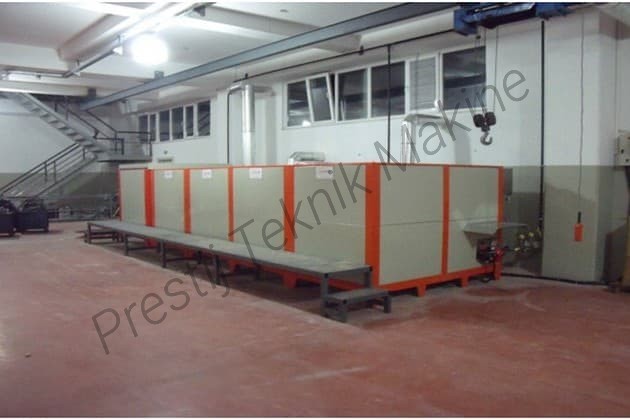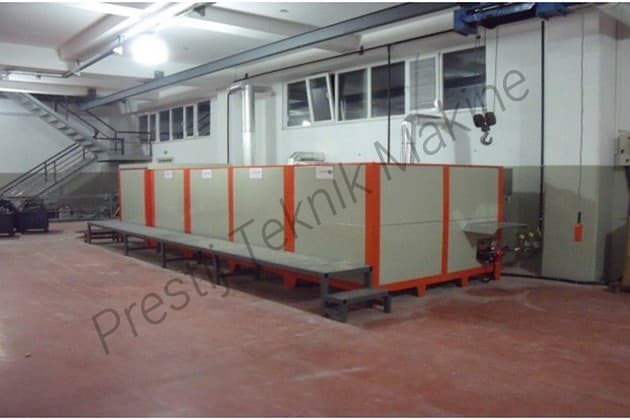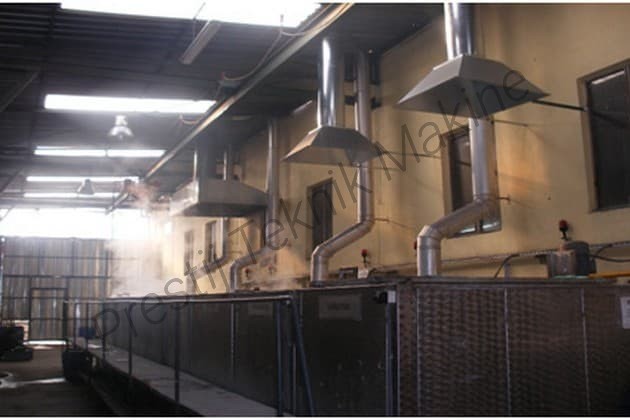IMMERSION TYPE CLEANING LINES |

Iron Phospate ImmersionIt is a classical method in which the temperature, concentration and time parameters are effective.The first stage is the degreasing bath.The degrased material enters the rinsing chamber in the second step. The double rinse tank is more appropriate in terms of the lack of transport. As the first bath pH value is 14 and the iron phosphate bath pH value is 4-5, it is necessary for the minimum transport process (sludge, pH increase and cost) to operate at proper condition. The third stage is the iron phosphate bath. The parts remain in the iron phosphate bath at 45-55 ºC for 5-10 minutes and become phosphated. After the part has been left in the Passivation bath for 30-45 seconds, it is dried at a maximum of 130 ° C and it becomes ready for the painting process. It is recommended to paint the metal parts within the same day after phosphating. Since iron phosphate is a thin coating, there is a risk of rusting for 24 - 48 hours depending on weather conditions. The place where the corrosion resistance is highest is below the coating of the part. |

Zinc Phospate ImmersionThis process requires at least three process baths. If, in addition, acid and activation baths are installed, the number of baths together with the rinsing baths will reach to 7-10 baths.If there is rust on the material, it is absolutely necessary to use acid bath. The phosphatization of the scale and rust free metal in the acid tank will affect the quality positively. The issue to be considered here is that the rinse bath should be changed frequently. If the amount of transport is excessive, the balance of zinc phosphate bath will be affected negatively. Activation is not needed if zinc phosphate crystals are thin. If crystals are thick, activation baths are used and baths must be ventilated. Activation makes homogeneous and thin crystalled layer. Reaction times reduce. The material remaining in the zinc phosphate bath for 5-10 minutes is treated in the passivation bath for 30-45 seconds and taken to drying process.The zinc phosphate bath may be a one-component, depending on its properties, as well as three components with pH regulators and accelerators. In wire drawing and tube drawing operations, zinc phosphated and soap treated pieces become ready for drawing. |

Aluminium Chromat ImmersionSimilar to the phosphating process applied on iron and steel materials, chromating process is applied on aluminum material. Aluminum can be coated with chromate in yellow, green and transparent colors. Yellow chromate coats Cr+6, green and transparent chromate coats Cr+3. The chromat thickness can vary between 0.4 - 1.5 gr/m² according to application time and type. Drying temperatures should not exceed 65 ° C for yellow and 85 ° C for green and transparent chromate. Another point that needs to be taken into consideration is that oil should not remain on the metal material and must be properly abraded. If hot degreasing is applied, a dilute caustic bath can be used to abrade it, followed by a nitric acid bath to neutralize it. If acidic degreasing is applied, the abrasion process is also performed in the same bath. Both chromate and paint will better adhere to degreased and abraded aluminum material. |

|

|

|

 info@tozboyatesisleri.com - info@prestijteknikmakine.com.tr
info@tozboyatesisleri.com - info@prestijteknikmakine.com.tr